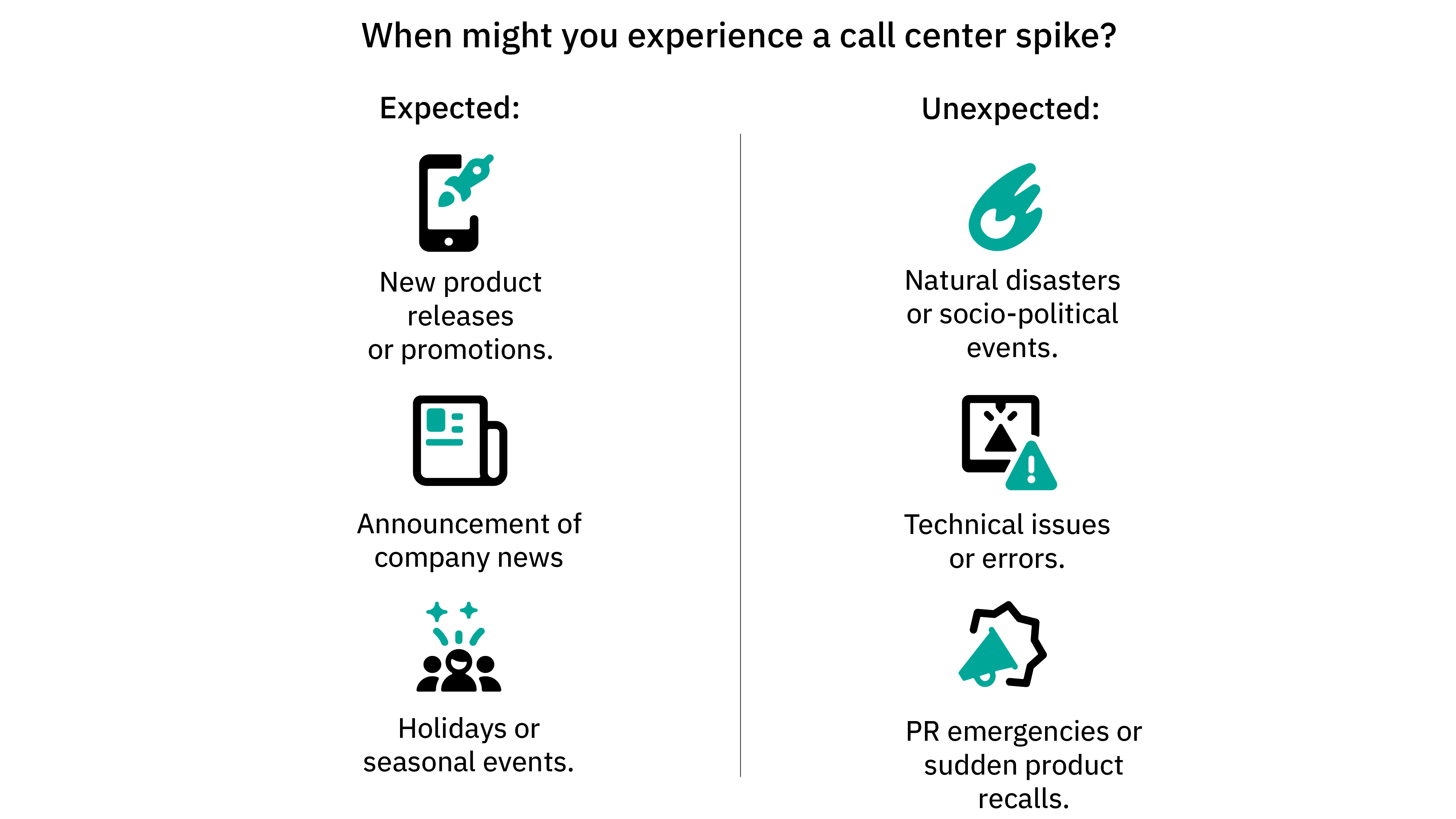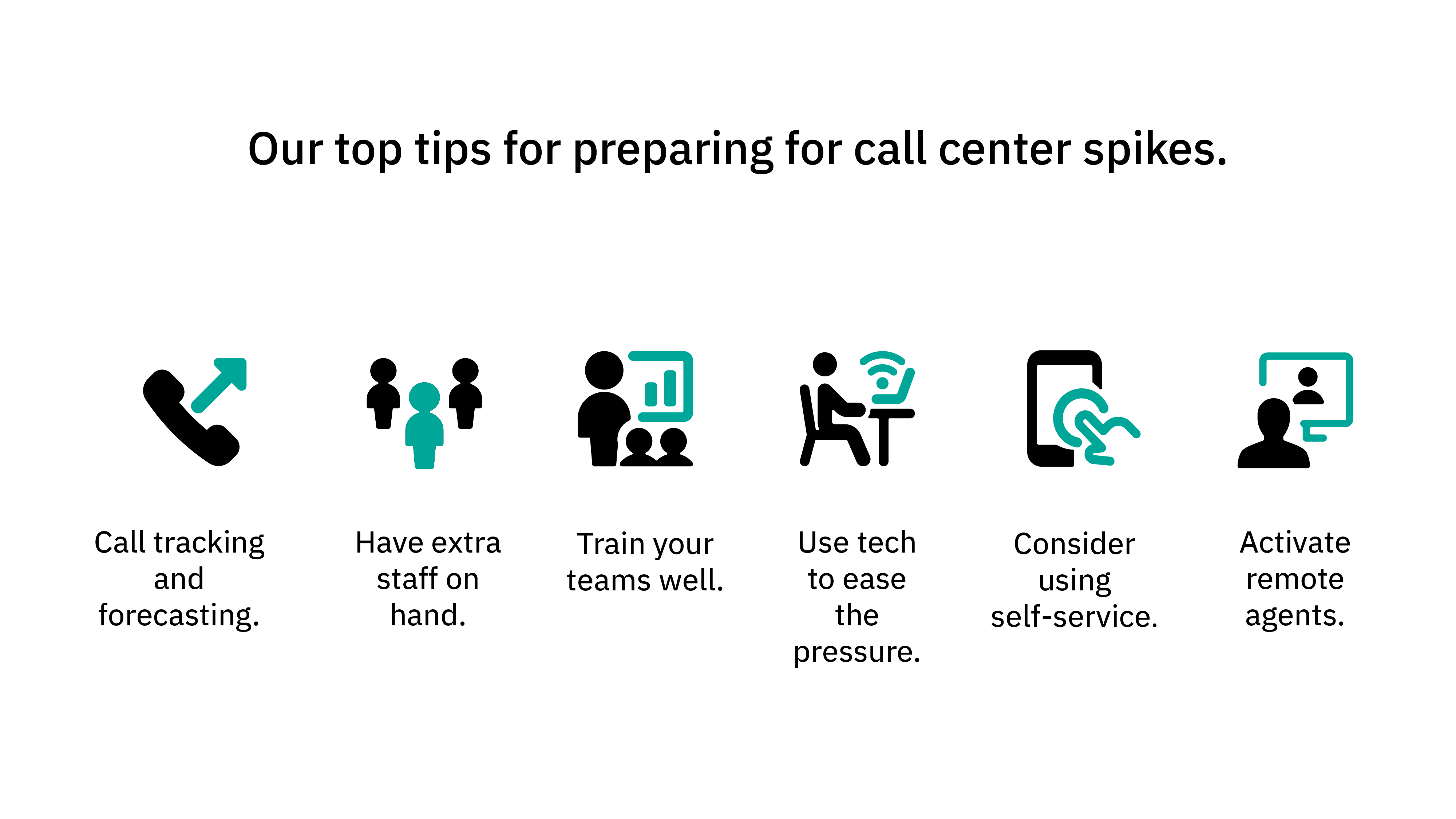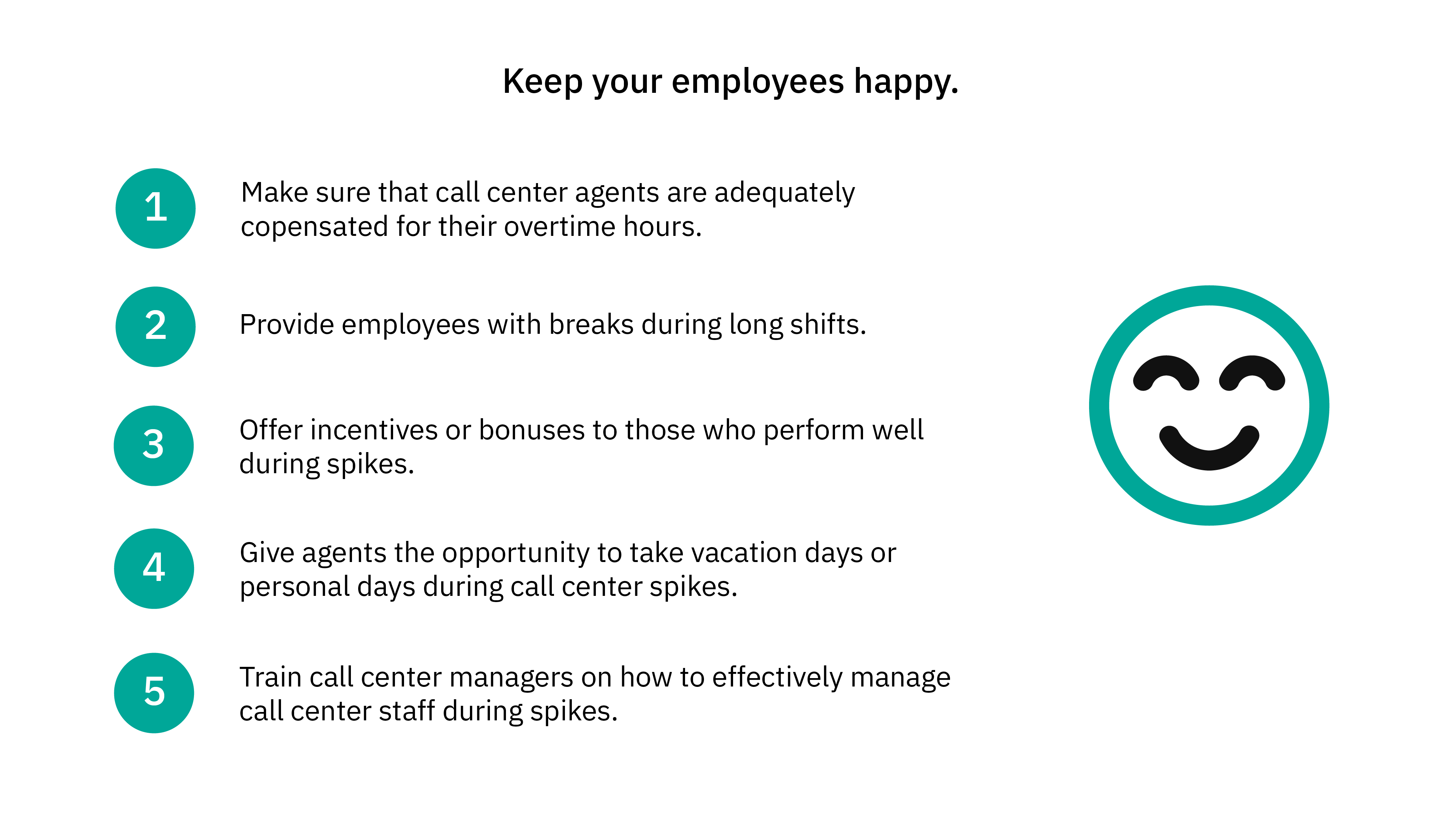How to prepare for call center spikes

What is a call center spike?
A call center spike is a sudden, significant increase in call volume. Spikes can be caused by a number of factors, including special promotions, unexpected customer service issues, or even the weather. Whatever the cause, spikes can be difficult to handle if you're not prepared.
That's why it's important to have a peak management plan in place to deal with call center spikes. By being prepared, you can ensure that your call center is able to handle the increased volume without missing a beat.
When might you experience a call center spike?
Expected:
- New product releases or promotions.
- Announcement of important company or industry news.
- Holidays or seasonal events.
Unexpected:
- Technical issues or errors.
- Natural disasters or socio-political events.
- PR emergencies or sudden product recalls

How can a call spike impact your business?
Call center spikes can have a significant impact on your business. If you're not prepared, they can lead to long wait times, frustrated customers, and abandoned calls. In addition, spikes can put a strain on your call center agents, leading to burnout and turnover.
The customer is always right.
70% of customers have switched brands due to a poor customer service experience (for example, long hold times) and 54% have made purchase decisions based on the quality of customer service according to the Zendesk CX trends report.
This means that call center spikes can have a significant impact on customer experience. When callers are unable to reach a call center agent in a timely manner, they are likely to become frustrated and may even take their business elsewhere. And that’s something we definitely don’t want.
Avoiding burnout and turnover.
Your agents are your greatest asset, and without their commitment and performance, it will be difficult to handle not just call volume spikes, but daily operations in general. Many employees report feeling overwhelmed during such spikes and feel as though more can be done to ease the impact on their workflow.
In an industry where high turnover is already a challenge, there are many initiatives you can put in place to ensure that agents feel supported even during moments of additional pressure.
Lost business and opportunity.
Customer frustration, employee stress, and amidst it all… losing out on opportunities to connect with your consumer base and drive further business. Call center spikes, whether expected or not, can significantly impact KPIs not just in the moment, but for months to come.
Keep reading to find out how best to prepare for increased call volumes and go from wary to ready.
Our top tips for preparing for call center spikes.
From having extra staff on hand, using data to predict call volume spikes, to effective training of your teams, there’s a multitude of ways you can prepare for sudden increases in inbound calls. We’ve summarized them for you below.
- Call tracking and forecasting.
- Have extra staff on hand.
- Train your teams well.
- Use tech to ease the pressure.
- Consider using self-service.
- Activate remote agents

Call tracking and forecasting.
Call tracking is the process of monitoring, recording, and analyzing telephone calls made to and from a call center. This information can be used to improve call center operations and identify areas for improvement.
Call forecasting is the process of predicting future call volumes based on historical data. This information can be used to plan for call center staffing and ensure that agents are available when call volume is high.
Both call tracking and call forecasting can be useful tools for preparing for call center spikes. By understanding call patterns and volume, you can better plan for times of increased call volume and ensure that your call center is prepared to handle the spike.
Have extra staff on hand.
When a spike occurs, you're going to need all hands on deck. Have a plan in place for bringing in extra staff, whether that means calling in reinforcements from other departments or hiring temporary workers.
By analyzing data from call forecasting and working closely with other departments such as recruitment and HR, you can ensure that everyone in your organization is aware and prepared for any necessary ramp ups before a call volume spike.
Train your teams to handle call spikes.
Your agents will need to be prepared to handle the increased call volume. Make sure they are properly trained and comfortable with the scripts and procedures they'll be using. Work together with your clients to develop better training opportunities and materials for them to use.
Consider investing in e-learning platforms and performance management tools to aid in this process. At Transcom, our use of the Transcom University and Transcom Coach platforms has greatly increased agent retention and reduced AHT for some of our biggest clients.
Use tech to ease the pressure.
There’s a plethora of tech that you can implement to help ease both customer and agent frustrations during a spike, including automation, machine learning, voice bots, and routing bots. Call deflection is a must, for example. By using call deflection, you can ensure that each call is handled in a timely manner and that no callers are left waiting on hold for an extended period of time.
Call back technology is a call center tool that allows callers to request a call back from an agent, rather than waiting on hold. This can be a valuable tool for managing call center spikes, as it can help to reduce call volume by allowing callers to schedule a call back when they have time.
Consider using self-service.
Self-service can be a valuable tool for managing call center spikes. By using self-service options, such as an automated call back system or an online knowledge base, customers can resolve their issues without having to wait on hold or speak to a call center agent. This can free up agents to handle other calls and help to reduce call volume during spikes.
In addition, self-service can help to improve customer satisfaction by providing a faster and easier way to resolve issues.
Activate remote agents.
If you have the ability to bring on remote employees, this can be a great way to improve call center operations during spikes. Remote call center agents can help to reduce call volume by taking some of the calls that would normally be handled by on-site teams.
In addition, remote workers can provide coverage for employees who are on vacation or out sick. This can help to ensure that calls are still being answered even when call center staff is limited.
Finally, remote agents can be a cost-effective way to handle spikes, as you will not need to pay for their travel expenses or provide them with office space.
The role of data.
Data can be a valuable tool for preparing an effective peak management plan. By analyzing call data, you can identify patterns and trends that can help you to predict when call volume will increase. This information can be used to plan for call center staffing and ensure that agents are available when call volume is high.
In addition, data can help you to identify call center bottlenecks and areas for improvement. By understanding where calls are getting stuck, you can make changes to your call center operations that can help to reduce call volume during spikes.
Keep your employees happy.
Keeping your employees happy during call center spikes is crucial, as this is a stressful time for them as well. Here are some tips for managing call center staff during spikes:

- Make sure that call center agents are adequately compensated for their overtime hours.
- Provide employees with breaks during long shifts.
- Offer incentives or bonuses to those who perform well during spikes.
- Give agents the opportunity to take vacation days or personal days during call center spikes.
- Train call center managers on how to effectively manage call center staff during spikes.
- Have a plan in place for employees who call in sick or are otherwise unable to work during a call center spike.
In conclusion.
Call center spikes can present a multitude of obstacles to overcome for even the most experienced providers. They can be planned or unexpected, but regardless of their cause, it’s crucial to know how best to prepare for the challenges they bring. With these top tips, you can turn this thorn in your side into a mild distraction.